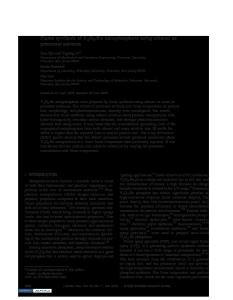Optically Stable Biocompatible Flame-made SiO 2 -coated Y 2 O 3 :Tb 3+ Nanophosphors for Cell Imaging
- PDF / 7,641,956 Bytes
- 6 Pages / 612 x 792 pts (letter) Page_size
- 31 Downloads / 329 Views
Optically Stable Biocompatible Flame-made SiO2-coated Y2O3:Tb3+ Nanophosphors for Cell Imaging G.A. Sotiriou*, D. Franco**, D. Poulikakos**, A. Ferrari** *
**
Particle Technology Laboratory, [email protected] Laboratory of Thermodynamics in Emerging Technologies, [email protected] Department of Mechanical and Process Engineering Swiss Federal Institute of Technology (ETH Zurich) Sonneggstrasse 3, CH-9092, Zurich, Switzerland
ABSTRACT Nanophosphors are a promising new class of inorganic labels for bio-imaging applications, possessing a narrow emission bandwidth, good photostability and low toxicity. The effect of crystallinity of the host matrix on the phosphorescence of Tb-doped (1-5 at% Tb) Y2O3 nanophosphors is explored. Nanophosphors with different crystal phase (cubic and monoclinic) and morphology (uncoated and SiO2-coated) but with similar sizes were prepared by flame spray synthesis. That allowed the direct comparison of their phosphorescence performance excluding any observed size effect. The as prepared nanophosphors were characterized by X-ray diffraction, high resolution electron microscopy and photoluminescence spectroscopy. The metastable monoclinic crystal structure of Y2O3:Tb3+ nanophosphors favors their green phosphorescence. INTRODUCTION Rare-earth oxide phosphors are employed in a variety of applications including highdefinition displays (1), lasers (2) and bio-imaging (3). Yttrium oxide (Y2O3) is one of the most studied ceramics as host matrix, especially when doped with europium (Eu3+) ions resulting in a bright red emission. However, when Y2O3 is doped with other lanthanide ions, the emission color can be tuned as it strongly depends on the chosen element. For example, when Y2O3 is doped with terbium (Tb3+) ions, a bright green emission occurs. In fact, the color of nanosized Y2O3 nanocrystals can be finely tuned from bright green to red by codoping them with Tb3+ and Eu3+ ions (4). Such nanocrystals have advantageous application in bio-imaging as they do not degrade during imaging (photobleaching) compared to organic dyes and are relatively non-toxic when compared to semiconductor nanocrystals (quantum dots) (3, 5-8). The crystal structure of the host matrix as well as the particle size can influence the luminescent properties of the nanophosphors material (4, 9, 10). Many studies investigate mostly the luminescence of cubic (9, 11-13) Y2O3 nanoparticles doped with Eu3+, since the cubic phase is the thermodynamically favorable phase at ambient pressure and temperature till 2325 °C (14). The meta-stable monoclinic phase can also be obtained, especially when processes with high temperatures and fast cooling rates are employed (9, 15). The red emission of monoclinic Y2O3:Eu3+, however, is less intense than the one obtained by its cubic crystal structure (9). Therefore, there are only a few studies that investigate the luminescent properties of monoclinic (9, 15-17) Y2O3:Eu3+ nanoparticles and even fewer that involve other lanthanide ions (17).
Here, Y2O3:Tb3+ nanophos
Data Loading...











